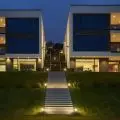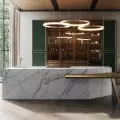interview from A&B issue 7/8 | 2022
Intimate, warm, thoroughly positive, beautiful, wise and important - this is how the exhibition created by the CENTRALA group, Aleksandra Kędziorek and Alicja Bielawska, can be described in a nutshell. Its creators talk about the importance of soft layers of architecture and, referring to historical examples, show that today it is also worth reaching for forgotten solutions. Cladding architecture has many dimensions, in addition to the aesthetic aspect creating climate and mood, it is related to temperature regulation - cooling and warming, both inside and outside. The exhibition, which runs until August 28 at the Szołayski House, is co-organized by the National Museum in Cracow and the Adam Mickiewicz Institute.
With the creators of the exhibition "House Clothed. Tuning in to seasonal imagination" is interviewed by Katarzyna Jagodzinska
Katarzyna Jagodzinska: You show at the exhibition the tradition of clothing architecture. Only some of its elements are in more common use today, such as rugs on the floor, others have disappeared somewhere. Why is it important to clothe architecture? What is most important from your point of view - aesthetic considerations, thermal considerations, continuity of tradition?
Aleksandra Kędziorek: We look to the past, searching in it for answers to the questions we currently face. In the case of textiles, more than their decorative qualities, we were interested in how they helped shape the microclimate of the home, that is, moderate humidity, temperature and lighting, before electricity, central heating or air conditioning became widespread. These technologies have made us lazy to some extent. They have made it so that we don't have to constantly think about the conditions we live in, because houses do it for us - they design our comfort. Today, however, the world is changing a lot and requires us to be more attentive and consciously participate in various processes. Fabrics are one method of shaping the microclimate of the home, which can inspire contemporary design. We do not mean to abandon the achievements of civilization and return exclusively to clothing the home, but to remember these solutions - low-cost both economically and environmentally. Air conditioners, which keep us comfortable and cool the interiors of our homes, at the same time release heat to the outside, and this increases carbon dioxide levels and hastens climate catastrophe. They are also programmed for conditions we are familiar with - traditional solutions may paradoxically prove more flexible and useful in realities we cannot yet imagine today.
Bedspread, rugs, bolsters, backing - architectural garments in warm tones for the cold seasons
Photo: Michal Matejko, courtesy of the Adam Mickiewicz Institute
Malgorzata Kuciewicz: This project continues the idea that architecture can be chronobiological* - it can be a coating of different materials, both hard and soft, that makes us more attentive to the world. This idea germinated in us when we spoke to A&B in February 2019 [cf. A&B 02/2019, issue compiled by Central - ed. note]. The concept itself was created for a competition, organized by the Adam Mickiewicz Institute, for the design of an exhibition in the Polish pavilion at the London Design Biennale 2021. The Biennale was held under the theme "Resonance." For us it was important to see that architecture can help synchronize with different cycles. At the time, we were most fascinated by the cycle of the twelve Polish seasons. When we worked as a team on the competition proposal, we chose twelve from a huge number of references - the works shown in the exhibition represent only a slice of the typology of domestic fabrics. By treating architecture as a medium through which we can be present in the cycles of nature, seeing the nuances between seasons, we won't save too much energy, but will be much more sensitive to the slow blurring of the differences between the twelve seasons.
Simone De Iacobis: I would add one more element - the performative aspect. We can practice the act of clothing our bodies on our homes as well. Home as an extension of our bodies.
The kilim shows a circle of twelve seasons; today the differences between them are blurred;
in pre-modern times, life followed their rhythms;
Woven by hand: Cooperative of Work of Folk and Artistic Crafts "Koronka Bobowa"
(Agata Król, Danuta Myśliwiec), embroidery: Jadwiga Śliwa
Photo: Michal Matejko, courtesy of the Adam Mickiewicz Institute
Malgorzata: In the text for our exhibition catalog, Witold Rybczynski mentioned that the words "décor" and "costume" are very close to each other. At the Central Textile Museum in Lodz, we learned that once the distinction between fabrics for the home and for the body was blurred. A good example is the bedspread - it was imposed on the bedding, but in great frosts it could also be imposed on oneself. In the names of these fabrics you can also see the connection with the body, for example, zaplecek is something behind the back, that is, it is a membrane between the body and the house.
Alicja Bielawska: For me, thinking about fabrics is related to perception, sensuality, touch, experiencing different surfaces. The way of hand-weaving emphasizes these qualities. When we introduce fabrics into interiors, we also add a layer of color, which influences how we perceive interiors, how we feel in them. When we talk to the exhibition's viewers, a recurring theme is memory - memories passing from generation to generation of how fabrics used to be used.
Margaret: When we worked on the competition project, we found that in each of our families some traditions are still preserved. My grandmother has different quilts for different seasons and the color determines their purpose.
A backing to insulate a wall during cold weather; Wawel Royal Castle, 1930
© National Digital Archive
Catherine: Are your houses clad?
Aleksandra: This was one of the first gestures I made after moving to a new apartment - it's a natural gesture of inhabiting a space. When we were doing research for the project, we discovered how the Wawel tapestries functioned. Sigismund Augustus traveled with them and clothed each successive castle. This gesture was repeated by the nobility - the bare walls were given domesticity through the ritual of clothing the space.
Malgorzata: When we discussed the exhibition with anthropologist Kacper Poblocki, for him the gender layer was interesting, because in the history of architecture the history of soft layers has disappeared. We also touched on this aspect related to the feminine side, for example, the institution of dowry - it was in the dowry that the soft layers of architecture were brought in, they sometimes took a very long time to create, they were the shells to clothe and unclothe the house, and this part of the history of architecture has been erased.
Simone:At first the exhibition was called "The Clothed House," but then we understood that architecture is the house, and fabrics make the house home. It's the difference between a hard shell and an inner swag that's cozy.
Alexandra: I would also add that this is a comfort achieved for a while - once we have made a space for ourselves, then we have to take care of it all the time and react to the changes happening around us. It is also important that the fabrics had a second life. Not only was the dowry created for a long time, but the fabrics also lived for a long time, they were transformed from one into another until they were completely worn out, for example, tablecloths became cloth or rugs over time.
The sidewalk creates warm paths along the route of daily domestic walks
Photo: Zofia Rydet, Sociological Record 1978-1990 (Podhale), 1980s. © 2068/12/31 Zofia Augustyńska-Martyniak, CC BY-NC-ND 3.0 EN
Malgorzata: We were delighted to find references in various registers, in magnate houses and in cottages in open-air museums. The biggest surprise was to discover that there was also a lot of fabric in iconic modernist architecture that historians had not mentioned for a long time. Now, for example, we are constantly correcting ourselves when talking about Mies van der Rohe and Lilly Reich's buildings, because she was responsible for the fabrics in their modernist interiors. We often work with reconstructions, we prepare materials for making mock-ups of forgotten architectural projects, and plants or fabrics have traditionally not been illustrated in miniature objects. We want to claim this part of architectural history.
Simone:Great architects like Frank Lloyd Wright, Bernard Rudofsky and Walter Gropius used fabrics, instead of walls or roofs.
Canopy, zaplecek, mucholap - the clothing of architecture in cool shades for warm seasons
Photo: Michal Matejko, courtesy of the Adam Mickiewicz Institute
continued conversation on next page
























































